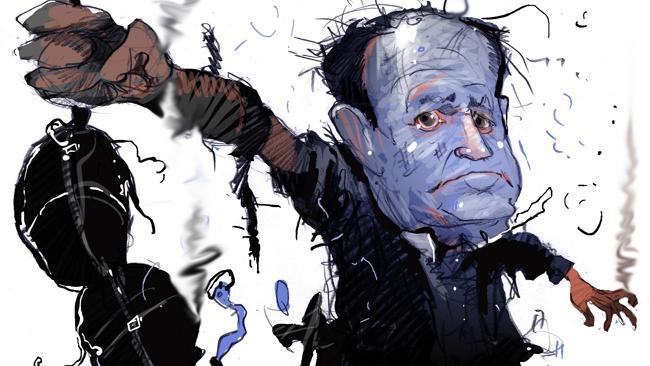
JUST when you thought things couldn’t get any creepier, Bill Shorten has turned to the radical fringes of 1960s euro-communism in search for a policy to end the subjugation of Australian women.
In November, he told the National Press Club that the progress of society depends “on assisting the march of women through the institutions of power”.
To flirt with the language of cultural Marxism in a single speech could be dismissed as banter. To flirt for a second time, however, as the Opposition Leader did last week, suggests he actually means it.
The long institutional march is a legacy of the thuggish, subversive world of West German political activism at the height of the Cold War. In 1967, the radical student leader Rudi Dutschke invoked the imagery of Mao Zedong’s Long March to advocate the infiltration of workplaces, universities and other institutions to execute radical change from within.
Dutschke died in 1979 but his madcap metaphor survived within enclaves of the crackbrained Left and now, apparently, in the policy of the Australian Labor Party.
Ever since Julia Gillard’s dishonest attack on Tony Abbott’s alleged sexism took off on YouTube and the compilers of the Macquarie Dictionary devalued their brand by redefining the word misogyny, Labor has appeared convinced that feminism is a political trump card.
Egged on by a noisy lynch mob, whose members include the “frightbats”, memorably named by The Daily Telegraph’s Tim Blair, Labor jumps on the PM’s words and gestures as evidence of chauvinist piggery of the lowest order.
That it is a deceitful slur on the Prime Minister’s character matters not a jot. What’s bad for Abbott is good for Labor and good for the country, it seems to think, and therefore anything goes.
In any case, what else has the party got to go on? Having rejected the grounded approach of Bob Hawke and Paul Keating, the party has little to offer except sentimentalism.
The worker’s party has become the warm and fuzzy party. It struggles to explain how to fix the budget but rest assured that once Labor is back in power Australia will be a fairer, more compassionate and more inclusive place.
Gender equity seems at first glance to be a natural fit for the self-styled party of virtue. Yet a fairer deal for the fairer sex (undoubtedly we’re not allowed to call them that) has been a bipartisan aim for as long as anyone can remember. The legal and institutional barriers to equality fell long ago and if, perchance, some residue of gender prejudice was discovered in the statute books, it would be removed without fuss.
To differentiate its product, Labor has made the dangerous leap from practical politics to the ideologically charged language of modern Feminism. It is siding with a crowd not content to merely improve the world; they think they have the formula to fix it.
Labor has taken this path before, most notably in 1983 when it broke from bipartisan policy on conservation to side with Bob Brown’s deep green ideologues and block construction of the Gordon below Franklin dam.
Graham Richardson called it “the perfect convergence” proclaiming “what was right was also popular”. Richardson, as it turned out, was wrong. Labor lost four blue collar seats in Tasmania in 1983, where unemployment rates were between 20 and 24 per cent.
By the late 1980s, the hardheads in Hawke’s cabinet were revolting against the insatiable demands of the environmental activists. “Every compromise, every agreement is seen by them to be no more than the launching pad for another assault on industry and employment,” wrote Labor’s finance minister, Peter Walsh.
Labor’s alliance with radical feminism will, in the long run, prove equally disastrous. Australians have a low tolerance for words ending in “ism”. They are in favour of taking care of our air, soil and water but are uncomfortable with deep green environmentalism — the misanthropic, utopian pursuit of biospherical purity in which the presumed rights of nature trump those of the human race.
They are in favour of equal opportunities for women and recognise that women often need additional support to pursue life’s opportunities. Few Australians, however, adhere to the ideology of feminism as it has evolved in our modern universities.
They might care about affordable childcare, but the destruction of a phallocentric society is not something that keeps the average Aussie awake at night.
Outside the other-worldly circle of frightbat feminism, few consider that gender inequality is “a direct result of the enforcement of patriarchal structures” and that women must fight to end “gender oppression”, as one columnist wrote recently in The Age.
In fact they do not believe that the world, with all its unpredictable twists and turns, is governed by structures of that kind at all. The world is imperfect because its seven billion inhabitants imperfectly struggle to manage the business of everyday life, not because of an oppressive, hegemonic “system”.
The world interpreted by common sense is unrecognisable from the world ordered by ideology. Common sense recognises that there are limits to what can be practically done by government to assist women, that change occurs incrementally and, in a democratic society, must be negotiated.
Common sense also recognises that gender inequality is not the sole obstacle to a perfect world. It understands that fairness is best advanced through prosperity.
It is no accident that the women’s movement grew alongside modernity, when increased wealth and technology created opportunities beyond a lifetime of nurturing the young.
The delusion that social injustice can be cured through social reform alone will eventually come unstuck.
Women’s lives will not be improved by marching through institutions. Liberty, democracy and prosperity are the engines of social progress.


